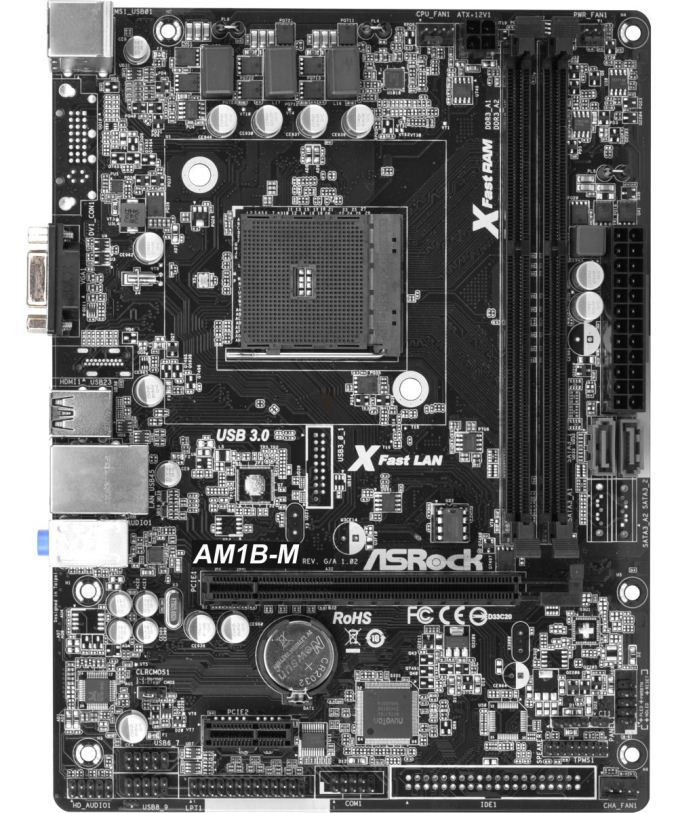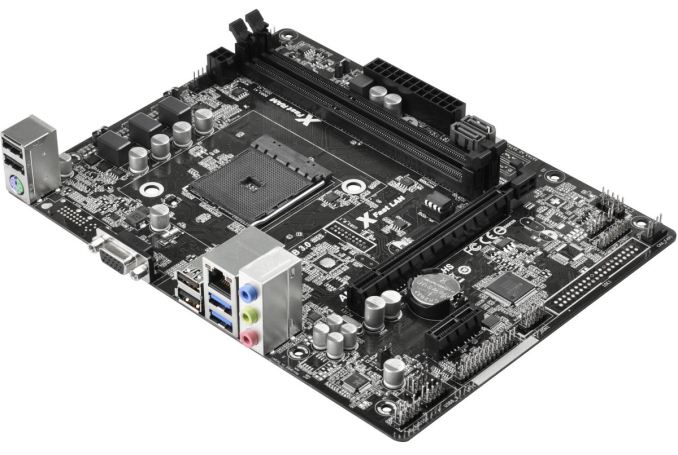The AM1 Kabini Motherboard Preview: Analyzing the Hardware
by Ian Cutress on April 19, 2014 2:00 PM ESTASRock AM1B-M
ASRock’s first motherboard falls under the $40 mark and also represents a slightly different variation on the theme. So far no two motherboards have been alike, and the ASRock AM1B-M exchanges the higher audio and video outputs instead for more rear USB 2.0 ports and an extra fan header. On the face of it, this does not seem like a good deal compared to the previous MSI, unless you need extra USB 2.0 ports.
The AM1B-M seems to have a lot of spots unoccupied by connectors. This is mostly likely due to variations of products, where the cheapest tends to have expensive connectors removed to hit a price point. We see two SATA ports missing, an IDE pin layout but no connector, and also a DVI connection missing on the rear panel. In the middle of the board is also a USB 3.0 pin layout, suggesting that another model has an additional USB 3.0 controller as well.
What the ASRock AM1B-M also does differently to all the motherboards we have examined before now is include a COM port, LPT port and a TPM port on the same PCB. It would be interesting to see which niche that combination would be good for.
The PCIe layout uses the PCIe 2.0 x4 from the chipset in a full sized slot, with an additional PCIe 2.0 x1 underneath. Thankfully the SATA ports are alternate facing for removing locking SATA cables, and the placement of the 4-pin CPU connector also helps cable routing. The AM1B-M has three fan headers, one more than the others – two on the top of the motherboard either side of the DRAM slots, and a third on the bottom right.
The AM1B-M has four USB 2.0 ports on the rear panel, or what I like to call my happy minimum (installing an OS via USB helps with at least three USB 2.0 ports). That being said, the sole VGA connector looks lonesome, and the ALC662 audio codec is not a particularly good choice.
| ASRock AM1B-M | |
| Price | Link |
| Size | Micro-ATX |
| CPU Interface | FS1b |
| Chipset | Kabini |
| Memory Slots |
Two DDR3 DRAM slots, supporting 16GB Single Channel, 1066-1600 MHz |
| Video Outputs | VGA (2048x1536 at 60 Hz) |
| Onboard LAN | Realtek RTL8111GR |
| Onboard Audio | Realtek ALC662 |
| Expansion Slots |
1 x PCIe 2.0 x16 (x4) 1 x PCIe 2.0 x1 |
| Onboard SATA/RAID | 2 x SATA 6 Gbps |
| USB 3.0 | 2 x USB 3.0 (Chipset) [rear panel] |
| Onboard |
2 x SATA 6 Gbps 2 x USB 2.0 headers 3 x Fan Headers 1 x TPM Header 1 x LPT Header 1 x COM Header Front Panel Header Front Audio Header |
| Power Connectors |
1 x 24-pin ATX 1 x 4-pin CPU |
| Fan Headers |
1 x CPU (4-pin) 1 x CHA (4-pin) 1 x SYS (3-pin) |
| IO Panel |
1 x PS/2 Combination Port VGA 2 x USB 3.0 4 x USB 2.0 1 x Gigabit Ethernet Audio Jacks (ALC662) |
| Product Page | Link |














64 Comments
View All Comments
coolhardware - Monday, April 21, 2014 - link
Sorry for the error on my part, I got the 5150 and 5350 mixed up :-(As per your original post, where did you see that nice 5150 OC? With an ASUS board should the same type OC be possible with the 5350?
Thanks!
yannigr - Tuesday, April 22, 2014 - link
At techpowerup. http://www.techpowerup.com/forums/threads/amd-kabi...But overclocking on this platform is still a big question mark. At Phoronix for example they also tried to overclock ALL the four processors available on the same motherboard and in ALL cases they had stability problems over 105MHz bus speed. So more time is needed to have a definite idea about the overclocking potential on this platform.
As for 5350 I don't know what frequency it can reach. 2100MHz should be easy I guess with just a multiplier change from 20.5 to 21, gut it does make you wonder why AMD didn't gave 5350 the 21 multiplier in the first place.
tech6 - Sunday, April 20, 2014 - link
The problem with the Kabini platform is that it makes too many sacrifices for too little gain. You can buy an Intel G3220 and an MSI H81M mobo for around $100 and while it may consume 10-15W (on paper) more power it will give you about twice the CPU power.As for real world power consumption, I recently build a G3220 system and even when under 100% max CPU and GPU compute using Hash Suite it never exceeded 60W. Under most everyday loads it used about 40W. Given these numbers it is difficult to make a case for the Kabini platform.
savagemike - Sunday, April 20, 2014 - link
I was contemplating similarly. I also wonder with the increased compute power if getting to idle quicker doesn't also attack any power savings.yannigr - Monday, April 21, 2014 - link
You gone from $60 to $100. This isn't "too little gain". Also you forget that the Kabini platform does have better graphics. Much better graphics. And I am not talking (only) about performance, but compatibility also.So, if you need cpu power and you have $100 you can go for Intel. But if you want a better balanced solution in gpu-cpu performance and keep $30-$40 in your pocket, Kabinis are the best option.
mikato - Wednesday, April 23, 2014 - link
I agree.Carleh - Tuesday, April 22, 2014 - link
Does the G3220 support hardware accelerated video decoding?It does support quicksync, but I'm not sure if quicksync can be used for hw accelerated video playback in all applications (flash includeed).
I know the G3220 is powerful enough to do all the decoding in software, but I see no point in using software video decoding in 2014.
Chicken76 - Sunday, April 20, 2014 - link
I remember from the slides that were presented by AMD at launch, that ECC RAM (unbuffered) was supported. Why isn't there a single motherboard that supports it? In it's current form, Kabini is not an option for building a cheap ZFS storage box.Death666Angel - Sunday, April 20, 2014 - link
Why does the motherboard need to support ECC RAM? I'm pretty sure they are physically identical to normal RAM and since the SoC handles all memory (as with most modern CPUs/APUs), the motherboard has no say in it.Chicken76 - Sunday, April 20, 2014 - link
I'm not sure, but if you're not using error correction on a DIMM, do you still need all the traces? They might not have them all in place, to keep costs to a minimum.Besides, you still need BIOS support for ECC.